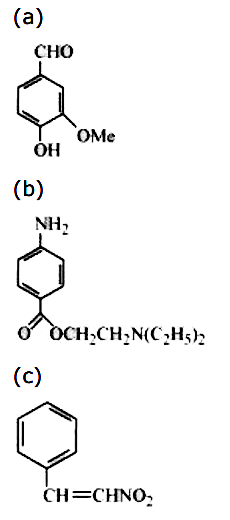Identify the atoms in each of the following compounds which do not obey the octet rule:
BCl3
To identify the atoms in the compound BCl3 that do not obey the octet rule, we can follow these steps:
1. Understand the Octet Rule: The octet rule states that atoms tend to form compounds in ways that give them eight valence electrons, achieving a noble gas electron configuration.
2. Determine the Valence Electrons:
- Boron (B): Boron has an atomic number of 5, which means its electronic configuration is 1s22s22p1. Therefore, boron has 3 valence electrons.
- Chlorine (Cl): Chlorine has an atomic number of 17, with an electronic configuration of 1s22s22p63s23p5. Thus, chlorine has 7 valence electrons.
3. Draw the Lewis Structure of BCl3:
- In BCl3, boron is the central atom surrounded by three chlorine atoms.
- Each chlorine atom shares one of its valence electrons with boron, forming a single covalent bond.
- The Lewis structure will show boron in the center with three single bonds to three chlorine atoms.
4. Count the Electrons Around Each Atom:
- Chlorine Atoms: Each chlorine atom shares one electron with boron, thus each chlorine atom has 8 electrons (7 from its own plus 1 shared with boron), satisfying the octet rule.
- Boron Atom: Boron shares its 3 valence electrons with the three chlorine atoms, resulting in a total of 6 electrons around boron (3 from the bonds with chlorine).
5. Conclusion:
- Boron does not have 8 electrons in its valence shell; it only has 6. Therefore, boron does not obey the octet rule.
- Chlorine atoms, on the other hand, do obey the octet rule as they achieve 8 electrons.
Final Answer:
In BCl3, the atom that does not obey the octet rule is Boron (B).
- Boron (B): Boron has an atomic number of 5, which means its electronic configuration is 1s22s22p1. Therefore, boron has 3 valence electrons.
- Chlorine (Cl): Chlorine has an atomic number of 17, with an electronic configuration of 1s22s22p63s23p5. Thus, chlorine has 7 valence electrons.
- In BCl3, boron is the central atom surrounded by three chlorine atoms.
- Each chlorine atom shares one of its valence electrons with boron, forming a single covalent bond.
- The Lewis structure will show boron in the center with three single bonds to three chlorine atoms.
- Chlorine Atoms: Each chlorine atom shares one electron with boron, thus each chlorine atom has 8 electrons (7 from its own plus 1 shared with boron), satisfying the octet rule.
- Boron Atom: Boron shares its 3 valence electrons with the three chlorine atoms, resulting in a total of 6 electrons around boron (3 from the bonds with chlorine).
- Boron does not have 8 electrons in its valence shell; it only has 6. Therefore, boron does not obey the octet rule.
- Chlorine atoms, on the other hand, do obey the octet rule as they achieve 8 electrons.
In BCl3, the atom that does not obey the octet rule is Boron (B).
Topper's Solved these Questions
- BOOK - ICSECHAPTER - CHEMICAL BONDING AND MOLECULAR STRUCTUREEXERCISE - VERY SHORT ANSWER TYPE QUESTIONS50videos
CHEMICAL BONDING AND MOLECULAR STRUCTURE
- BOOK - ICSECHAPTER - CHEMICAL BONDING AND MOLECULAR STRUCTUREEXERCISE - SHORT ANSWER TYPE QUESTIONS76videos
CHEMICAL BONDING AND MOLECULAR STRUCTURE
- BOOK - ICSECHAPTER - CHEMICAL BONDING AND MOLECULAR STRUCTUREEXERCISE - NCERT TEXT-BOOK EXERCISES ( WITH HINTS AND SOLUTIONS)47videos
CHEMICAL BONDING AND MOLECULAR STRUCTURE
- BOOK - ICSECHAPTER - CHEMICAL THERMODYNAMICS EXERCISE - NCERT TEXT-BOOK. EXERCISES22videos
CHEMICAL THERMODYNAMICS
Similar Questions
Identify the atoms in each of the following compounds which do not obey the octet rule:
PCl5View SolutionIdentify the atoms in each of the following compounds which do not obey the octet rule:
NH3View SolutionIdentify the atoms in each of the following compounds which do not obey the octet rule:
SF6View SolutionIdentify the atoms in each of the following compounds which do not obey the octet rule:
BeF2View SolutionIdentify the atoms in each of the following compounds which do not obey octet rule:
SO2,NH3,OF2,BCl3,PCl3View SolutionIdentify the following compound
 View Solution
View SolutionIdentify the functional groups in the following compounds
 View Solution
View SolutionIdentify the functional groups in the following compounds
 View Solution
View SolutionIdentify the functional groups is the following compounds:
 View Solution
View SolutionIdentify the functional groups is the following compounds:
 View Solution
View Solution

